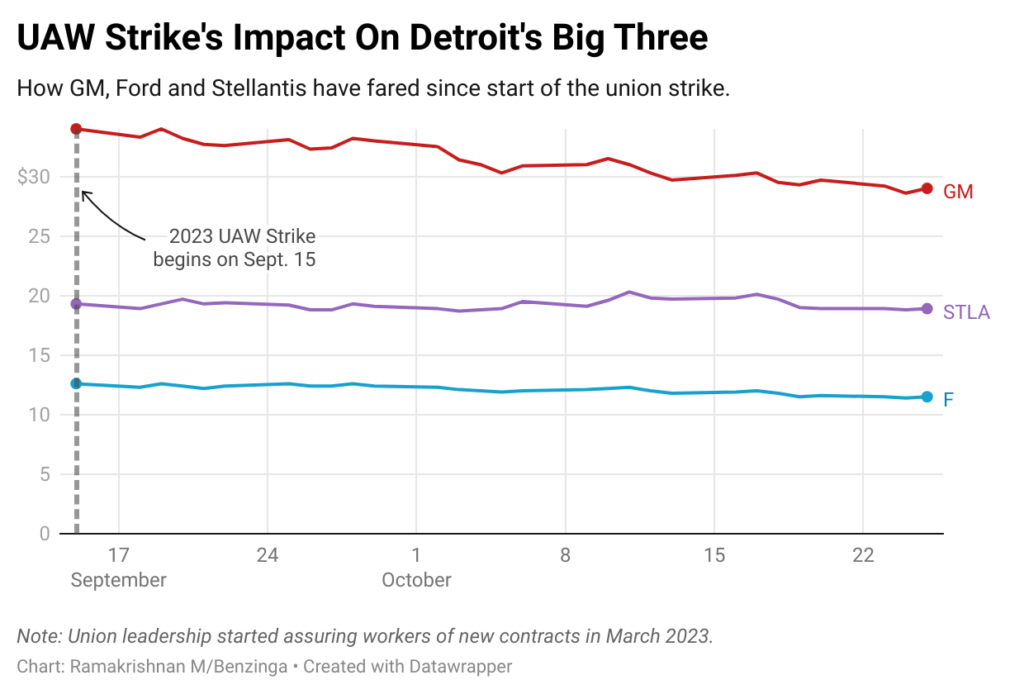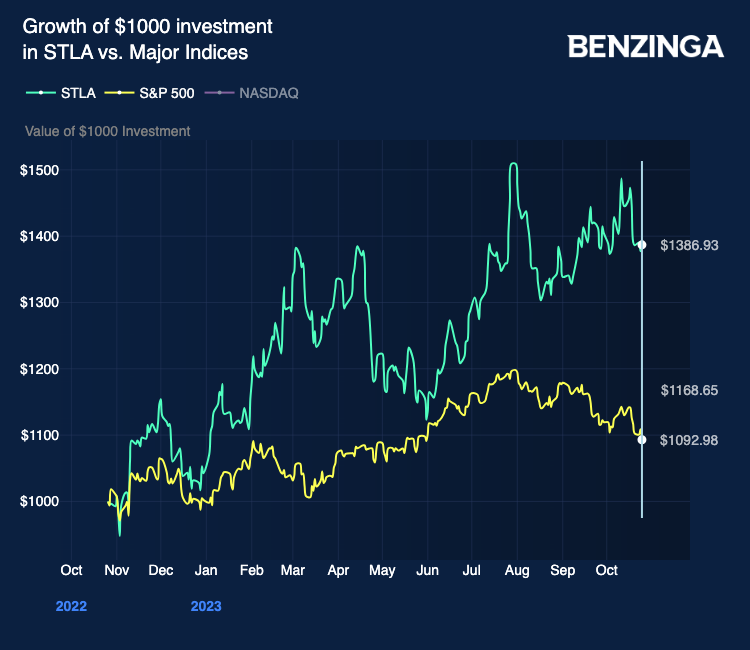Zinger Key Points
- The UAW strike has been a gut punch for automakers as the shares have been added to their losses since then.
- Analyst says Stellantis' structural earnings growth/resilience is among the highest of the EU/US OEMs.
- Today's manic market swings are creating the perfect setup for Matt’s next volatility trade. Get his next trade alert for free, right here.
The striking United Auto Workers union has struck a tentative deal with Ford Motor Co. F, potentially lifting an overhang around Dearborn. The ongoing strike that started around mid-September brought some of the main manufacturing plants of Detroit’s “Big Three” to a standstill and impacted production.
Here’s a look at how the shares of these companies, namely Ford, General Motors Corp. GM, and Stellantis N.V. STLA fared among the turbulence and what lies ahead of them.
Ford Vs. GM Vs. Stellantis Since UAW Strike
Shares of the three legacy automakers have languished since the start of the strike on Sept. 15. While Ford and GM have seen a broadly downward trajectory, Stellantis has traded in a broad range, even rallying from early October through the middle of the month before retreating along with the broader market.

On Sept. 15, autoworkers with allegiance to the UAW walked off from Ford’s Michigan Assembly Plant in Wayne, Stellantis’ Toledo Assembly Plant, where it builds Jeeps, and GM’s Missouri plant, which makes trucks. UAW President Shawn Fain clarified that the strikes would expand to other plants in phases if demands weren’t met.
For these automakers, which were already contending with an inclement economy, higher input costs, and a painful transition to electric vehicle manufacturing, the strike could not have come at a worse time. The demands on them were unrealistic, as has been opined by many.
They included the elimination of wage tiers, 35% wage increases, restoration of cost-of-living allowance increases, increased benefits such as health care, a traditional pension, a four-day work week with 32 hours per week of labor, and better protection for workers laid off due to the elimination of gas-powered train.
Wedbush analyst Daniel Ives called the strike a “gut punch” to the legacy automakers. Some industry watchers even flagged the risk of bankruptcy in the event of the automakers caving into UAW’s demands.
The union, led by Fain, was however stubborn and went ahead with the determination to fight till the last. The strike assumed a political dimension, with President Joe Biden and Sen. Bernie Sanders (I-Vt.) throwing their weight behind striking workers.
Automakers reacted by laying off employees at the striking plants. In late September, UAW announced its decision to expand the strike to the distribution centers and more Michigan plants of the automakers. On Oct. 11, the strike spread to Ford’s biggest plant, the Kentucky truck manufacturing plant.
See Also: Best Auto Manufacturer Stocks
F Vs. GM Vs. STLA: How Returns Stock Up Over Past Year
Over the past year, both Ford and GM stocks performed poorly, but Ford did worse. If you invested $1,000 in Ford a year ago, it would now be worth $989.64, resulting in a 1.04% loss. In contrast, the same investment in GM would have decreased to $773.97, indicating a 22.6% loss.

Figure: Comparison of scaled returns delivered by GM and F over a period of one year.
Chart courtesy of Benzinga
Stellantis, meanwhile, stands out with gains and has also outperformed the broader market, taking the S&P 500 as a proxy. The stock has surged up 53.37% over the past year compared to the 8.5% gain for the S&P 500 Index.

The relative outperformance of Stellantis is due to its resilience to the economic vagaries relative to other large automakers.
Stellantis was formed by the merger of U.S-Italian conglomerate Fiat Chrysler and France’s PSA Group and is headquartered in Amsterdam, Netherlands.
Recently, Barclays analyst Henning Cosman initiated coverage of Stellantis with an Overweight rating and 22.50-euro price target compared to the 17+ euro level it currently trades in the German stock exchange. “STLA screens among the best EU/US OEMs on EBIT margin, FCF, dividend and capital efficiency – but this quality isn’t reflected at 3.0x 2024 P/E, in our view,” the analyst said.
Cosman noted that the stock is trading near its all-time highs despite the UAW strike and said
the company’s structural earnings growth/resilience is among the highest of the EU/US OEMs.
Among GM and Ford, analysts are more optimistic about the former, as seen by the average upside projected by analysts. The mean rating also suggests the sell-side is bullish on GM and has preferred to stay on the sidelines on Ford.

Chart Courtesy of Benzinga
In premarket trading on Thursday, U.S.-listed shares of Stellantis were trading down 2.01% at $18.51, according to Benzinga Pro data. Ford rose 1.65% to $11.73 and GM fell 0.21% to $28.95.
Photos via Shutterstock
Edge Rankings
Price Trend
© 2025 Benzinga.com. Benzinga does not provide investment advice. All rights reserved.
Trade confidently with insights and alerts from analyst ratings, free reports and breaking news that affects the stocks you care about.